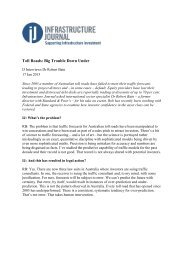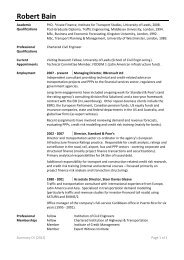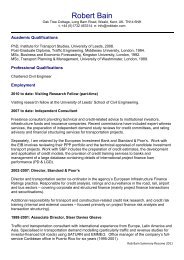Disincentivising overbidding for toll road concessions
Disincentivising overbidding for toll road concessions
Disincentivising overbidding for toll road concessions
- No tags were found...
Create successful ePaper yourself
Turn your PDF publications into a flip-book with our unique Google optimized e-Paper software.
DISINCENTIVISING OVERBIDDING FOR TOLL ROAD CONCESSIONS<br />
The introduction of private financing can ensure that projects that might not be financed with public money can<br />
feasibly be undertaken, and that risks are not borne solely by the public sector. At the same time, the increased<br />
scrutiny of private sector companies and their financiers, which are both putting their money at risk, should<br />
ensure that projects are undertaken only if they are likely to per<strong>for</strong>m well. 59 Indeed, the private sector may be<br />
better at evaluating risks than the public sector. 60 Jenkinson (2003) argues that private finance can also free<br />
managers from the ‘fickle and unreliable rules’ that govern public finance.<br />
On the other hand, Jenkinson (2003) argues that unless ‘contracts are easy to define, risks are well understood,<br />
transaction costs are low, and competition to provide finance is active’, private sector finance may push up the<br />
costs of financing a particular project. 61 There is also a risk of default, since project finance capital structures are<br />
usually highly leveraged. This might lead companies to try to renegotiate the contract and may even require the<br />
public sector to step in the case of bankruptcy.<br />
To summarise, under DBFOM the contractor is involved in all stages of the project, which should encourage them<br />
to take a holistic view of delivering the asset, and may create economies of scope.<br />
Asset privatisation<br />
As an alternative to DBFOM, where the public sector retains ownership of the asset, the asset can be fully<br />
privatised. This means that the public sector is required to relinquish any influence it has on the setting of<br />
<strong>toll</strong>s, the management of the asset and any future capacity expansion. Aside from this, the advantages and<br />
disadvantages of asset privatisation are similar to those <strong>for</strong> DBFOM contracts.<br />
The design of the concession is an important consideration since it will have an impact on the incentives faced by<br />
the firm in the bidding process (and once the concession contract has been awarded), and will typically determine<br />
the evaluation framework <strong>for</strong> bids. This might then be expected to determine the extent to which the firm can gain<br />
from strategically <strong>overbidding</strong>. For example, if the winning contractor is tasked with providing upfront finance <strong>for</strong> the<br />
project (as in DBFOM), the terms on which it is able to gain access to finance may be given significant weight in the<br />
appraisal process, and demand <strong>for</strong>ecasts may be given correspondingly less weight. The incentives <strong>for</strong> firms to push<br />
up demand <strong>for</strong>ecasts may then be weaker.<br />
On the other hand, DBFOM contracts provide greater scope <strong>for</strong> complementarities, a higher degree of prestige and<br />
might affect other non-financial drivers of <strong>overbidding</strong>.<br />
2.3.3 Bidding process<br />
One aspect which might be able to overcome, or at least lessen the impact of, optimism bias and strategic bidding—<br />
without changing the way in which <strong>for</strong>ecasts are made—is the design of the bidding process. The auction theory<br />
literature has highlighted two potential approaches to achieving this. First, the bidding process can be differentiated<br />
according to whether the winning party pays its own bid, or the bid of the second-highest bidder. Second, bids can<br />
either take place in the open, such that all participants know the prevailing price, or they can be sealed, such that<br />
they are not made public to other parties.<br />
Vickrey auctions 62<br />
In a ‘Vickrey auction’, bidders simultaneously submit sealed bids and the highest bidder wins the item. However,<br />
the winner does not pay their own bid, but instead pays the amount offered by the second-highest bidder. 63 Since<br />
the winning bid does not affect the price the winning bidder pays (only whether they do, indeed, win or lose), in<br />
theory there is no incentive <strong>for</strong> a rational bidder to misrepresent their value, and consequently there should be no<br />
<strong>overbidding</strong> in a Vickrey auction.<br />
59 Grimsey, D. and Lewis, M.K. (2004), Public Private Partnerships: The Worldwide Revolution of Infrastructure Provision and Project Finance,<br />
Cheltenham: Edward Elgar.<br />
60 Jenkinson, T. (2003), ‘Private Finance’, Ox<strong>for</strong>d Review of Economic Policy, 19:2, 323–34.<br />
61 Ibid., p. 333.<br />
62 Vickrey, W. (1961), ‘Counterspeculation, Auctions, and Competitive Sealed Tenders’, Journal of Finance, 16:1, 8–37.<br />
63 The highest bidder imposes an externality on the second-highest bidder by taking part in the auction (in preventing the second-highest bidder<br />
from winning the item). The second-highest bid is paid since this ‘internalises the externality’ of the bidding process.<br />
24






